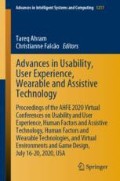Abstract
In this paper, a method is proposed for using virtual reality for concept design with the Gravity Sketch VR application and a virtual reality headset. The method for augmented concept design is then tested against traditional sketching on paper. The participants were thirteen product development master students, challenged to design backpacks in VR and on paper. Different parameters like efficiency, ease of use and enjoyment were measured through observation, a survey and a laddering interview. Even though the master students had no experience with virtual reality, the VR method scored surprisingly high on efficiency, effectiveness and ease of use. The participants specified that they enjoyed working with VR more, however none of them were likely to completely replace their traditional sketching methods. Nevertheless, this study supports the claim that virtual reality technology is ready for product design.
Access this chapter
Tax calculation will be finalised at checkout
Purchases are for personal use only
References
Steure, J.: Defining virtual reality: dimensions determining telepresence. J. Commun. 42, 73–93 (1993). https://doi.org/10.1111/j.1460-2466.1992.tb00812.x
Bryson, S.: Approaches to the successful design and implementation of VR applications. Virtual Real. Appl. 3–15 (1995)
Bricken, M., Byrne, C.M.: Virtual Reality: Applications and Explorations. Academic Press, Cambridge (1993)
Do, E.Y.-L.: The Right Tool at the Right Time–Investigation of Freehand Drawing as an Interface to Knowledge Based Design Tools. Georgia Institute of Technology (1998)
Schkolne, S., Pruett, M., Schröder, P.: Surface drawing. In: Proceedings of the SIGCHI Conference on Human Factors in Computing Systems - CHI 2001, pp. 261–268. ACM Press, New York (2001)
Tovey, M.: Drawing and CAD in industrial design (1989)
Berg, L.P., Vance, J.M.: Industry use of virtual reality in product design and manufacturing: a survey. Virtual Real. 21 (2017). https://doi.org/10.1007/s10055-016-0293-9
Nunes, M.L., Pereira, A.C., Alves, A.C.: Smart products development approaches for Industry 4.0. Proc. Manuf. 13, 1215–1222 (2017). https://doi.org/10.1016/J.PROMFG.2017.09.035
Israel, J.H., Wiese, E., Mateescu, M., Zöllner, C., Stark, R.: Investigating three-dimensional sketching for early conceptual design-results from expert discussions and user studies. Comput. Graph. 33, 462–473 (2009). https://doi.org/10.1016/j.cag.2009.05.005
Thorsteinsson, G., Page, T.: Creativity in technology education facilitated through virtual reality learning environments: a case study. J. Educ. Technol. 3, 74–87 (2007). https://doi.org/10.26634/jet.3.4.677
Fiorentino, M., De Amicis, R., Monno, G., Stork, A.: Spacedesign: a mixed reality workspace for aesthetic industrial design. In: Proceedings - International Symposium Mixed and Augmented Reality, ISMAR 2002, pp. 86–96 (2002). https://doi.org/10.1109/ISMAR.2002.1115077
Hart, S.G., Staveland, L.E.: Development of NASA-TLX (Task Load Index): Results of Empirical and Theoretical Research (1988)
Nichols, S., Patel, H.: Health and safety implications of virtual reality: a review of empirical evidence. Appl. Ergon. 33, 251–271 (2002). https://doi.org/10.1016/S0003-6870(02)00020-0
Häggman, A., Tsai, G., Elsen, C., Honda, T., Yang, M.C.: Connections between the design tool, design attributes, and user preferences in early stage design. J. Mech. Des. Trans. ASME 137 (2015). https://doi.org/10.1115/1.4030181
Author information
Authors and Affiliations
Corresponding author
Editor information
Editors and Affiliations
Rights and permissions
Copyright information
© 2020 The Editor(s) (if applicable) and The Author(s), under exclusive license to Springer Nature Switzerland AG
About this paper
Cite this paper
Van Goethem, S. et al. (2020). The Use of Immersive Technologies for Concept Design. In: Ahram, T., Falcão, C. (eds) Advances in Usability, User Experience, Wearable and Assistive Technology. AHFE 2020. Advances in Intelligent Systems and Computing, vol 1217. Springer, Cham. https://doi.org/10.1007/978-3-030-51828-8_92
Download citation
DOI: https://doi.org/10.1007/978-3-030-51828-8_92
Published:
Publisher Name: Springer, Cham
Print ISBN: 978-3-030-51827-1
Online ISBN: 978-3-030-51828-8
eBook Packages: EngineeringEngineering (R0)

